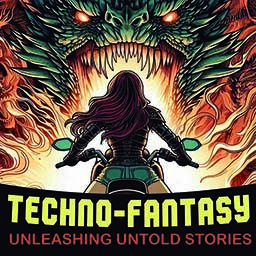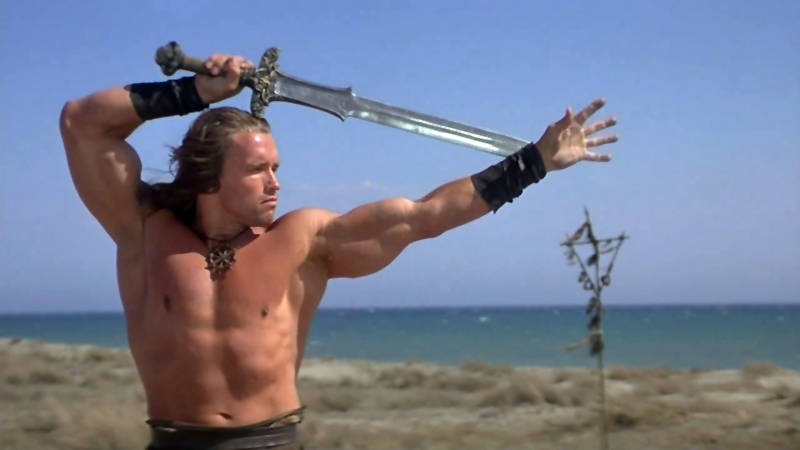Conan, what is best in life…?
(A free translation from a dialogue in Conan the Barbarian, 1982.)
To crush your enemies!
See them driven before you!
And to hear the lamentations of their women!
The adaptation of Conan the Cimmerian for the big screen marked a significant milestone in the character’s history, introducing him to an even larger and more diverse audience. Created by Robert E. Howard in the 1930s, Conan was already an iconic figure in pulp literature before conquering the silver screen. The cinematic portrayal of the barbarian is a journey filled with challenges, creative choices, and unforgettable moments, both in production and in the cultural impact it generated.
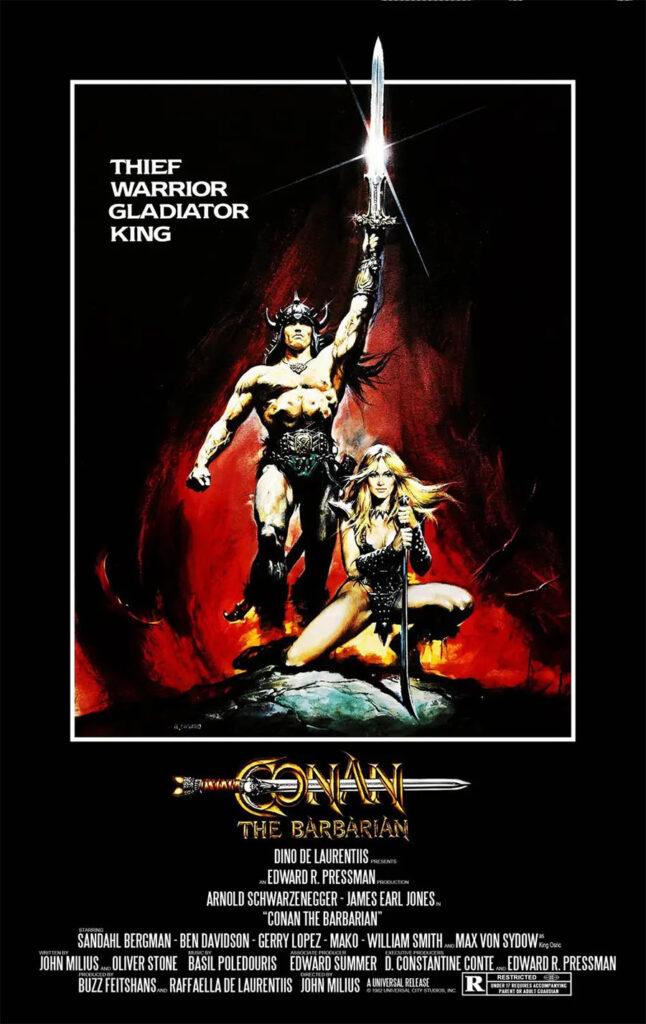
The movie Conan the Barbarian, directed by John Milius and starring Arnold Schwarzenegger, was released in 1982. The film is widely credited with popularizing the fantasy genre in cinema and establishing Schwarzenegger as an action star. The film’s production began with an initial script written by Oliver Stone, who envisioned a post-apocalyptic epic set in a dystopian future. Considered unfilmable by the studios at the time, the script was abandoned. However, when John Milius came on board as director, he rewrote the screenplay, returning to the essence of Howard’s original stories and situating the narrative in a barbaric world.Though the film diverged in some aspects from Howard’s original stories, it captured the essence of the character and Conan’s brutal world. The film’s dark and brutal aesthetic, combined with the epic score by Basil Poledouris, created a memorable experience for viewers. Milius incorporated his worldview and his love for military history into the development of the character and the setting, resulting in a work that blends philosophy, mythology, and epic adventure.
The Importance of Basil Poledouris’ Soundtrack
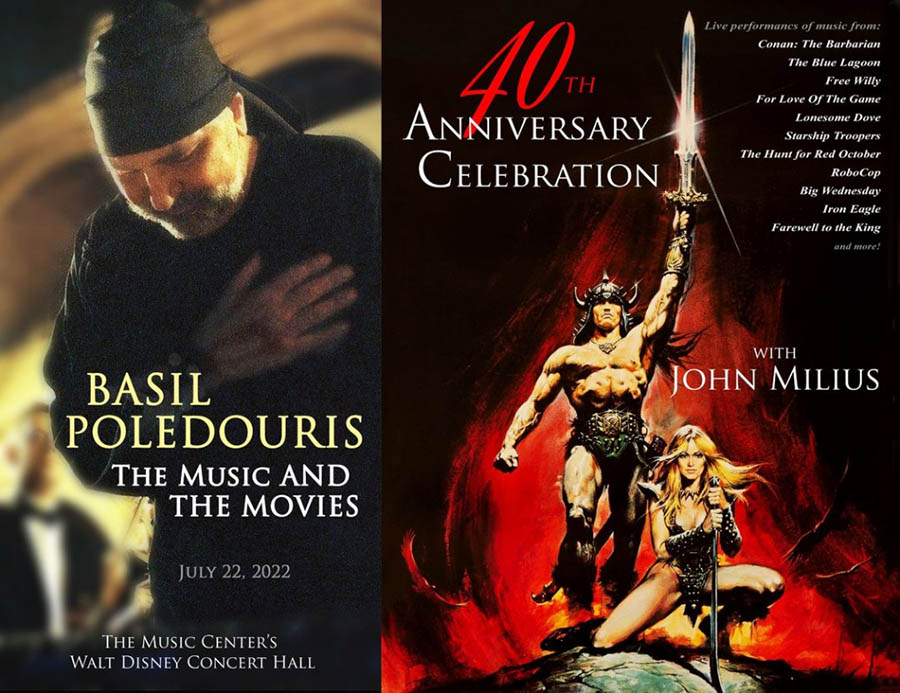
The soundtrack of Conan the Barbarian, composed by Basil Poledouris, played a crucial role in the film’s success. Poledouris’ music not only complemented the action and drama scenes but also enriched the narrative with an emotional depth that helped transport viewers to Conan’s brutal and epic world. The soundtrack is grand and evocative, using a full orchestra to create themes ranging from majestic and heroic to dark and menacing.The main themes, such as “Anvil of Crom” and “Riddle of Steel/Riders of Doom,” are particularly memorable and have become synonymous with the Conan character. Poledouris’ ability to blend classical music with elements of folk and tribal music helped define the tone of the film and establish a unique atmosphere that resonates with the barbarian essence of the character.
Behind-the-Scenes Facts
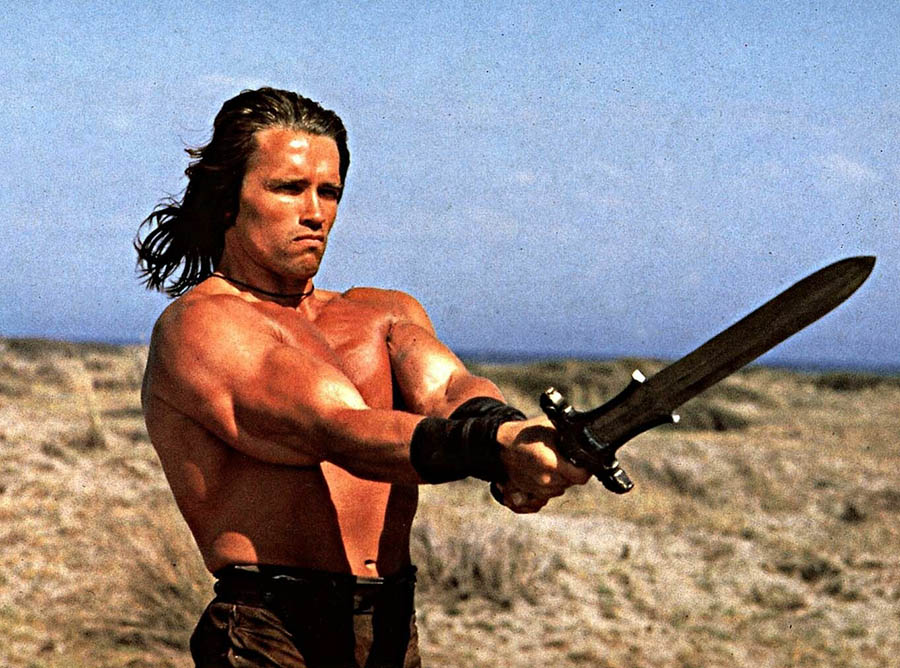
Ed Pressman and his associates considered Arnold Schwarzenegger the personification of Conan while working to secure the film rights. Summer revealed that they had considered Charles Bronson, Sylvester Stallone, and William Smith—all of whom had portrayed tough figures—but in 1976, the two producers watched a preliminary cut of the bodybuilding film Pumping Iron and agreed that Arnold Schwarzenegger was perfect for the role due to his enormous and muscular physique. According to Schwarzenegger, Pressman’s “subtle” approach and “great inner strength” convinced him to join the project. Paul Sammon, a writer for Cinefantastique, said the former bodybuilding champion was practically “the living incarnation of one of Frazetta’s illustrations.” Schwarzenegger was paid $250,000 and placed on hold, meaning the terms of his contract restricted him from starring in other sword and sorcery films. Schwarzenegger said that Conan was his greatest opportunity to establish himself in the entertainment industry.
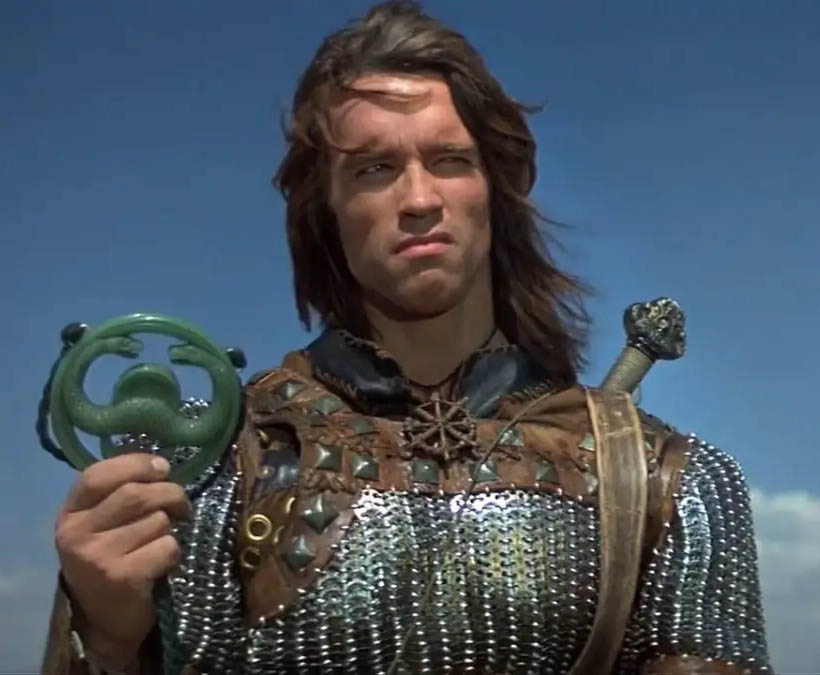
Thanks to Pressman’s strong belief in him, Schwarzenegger kept the role of Conan even after the project was effectively sold to De Laurentiis. Despite their first interview, where Schwarzenegger entered the producer’s office and said, “Why does a little man like you need such a big desk…” to which De Laurentiis ended the meeting, vetoing Schwarzenegger’s involvement, Pressman and Milius convinced the producer that Arnold was the best—if not the only—choice for the character of Conan. Milius wanted a more athletic look for his leading actor, so Schwarzenegger followed an 18-month training regimen before filming began. In addition to running and lifting weights, his routines included rope climbing, horseback riding, fencing, and swimming. He reduced his weight from 240 to 210 pounds (109 to 95 kg).
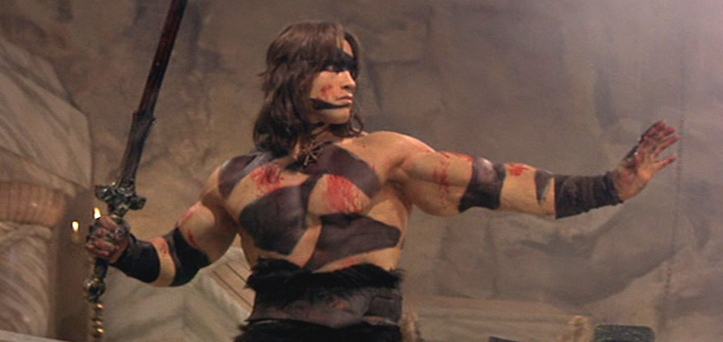
In addition to Conan, two other substantial roles were played by newcomers. Subotai was portrayed by Gerry Lopez, a champion surfer whose only significant acting experience was playing himself in Milius’ Big Wednesday. Schwarzenegger stayed at Lopez’s house for over a month before filming began so they could rehearse their roles and build a relationship. Sandahl Bergman, a dancer who had had small roles in several theatrical productions and films, played Valeria. She was recommended to Milius by Bob Fosse, who had directed her in All That Jazz (1979), and she was accepted after reading for the role. Milius wanted an actress who resembled a Valkyrie, and he found that profile in her.
Milius said the actors were chosen because their appearances and personas fit their roles. He wanted actors who had no preconceived notions to project onto their roles. Though Milius had reservations when he witnessed the first takes of the newcomers in action, he placed faith in their improvement over time and altered the script to fit their abilities. Schwarzenegger studied for weeks in 1980 under the tutelage of Robert Easton, a voice coach for many Hollywood stars, to improve his speech. His first line in the film was a paraphrase of the Mongol Emperor Genghis Khan’s speech about the good things in life, delivered with a strong Austrian accent: “To crush your enemies—see them driven before you, and hear the lamentations of their women.” Subsequently, Schwarzenegger underwent intensive voice training with Milius. Each of his later, longer speeches was rehearsed at least 40 times. Lopez’s lines also posed a challenge; though Milius was satisfied with Lopez’s work, the surfer’s lines were dubbed by stage actor Sab Shimono for the final cut. A source close to the production said this was because Lopez failed to “maintain a certain quality in his voice.”
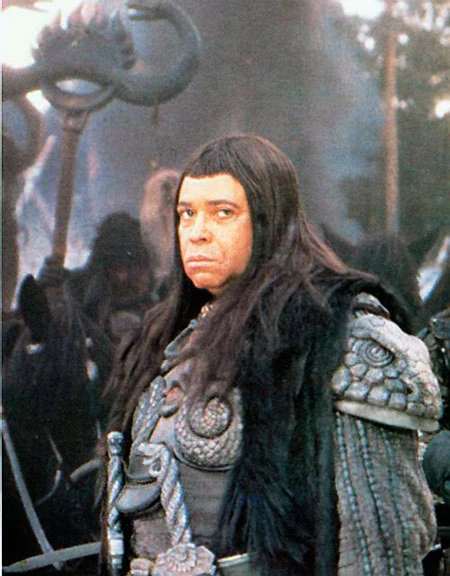
Sean Connery and John Huston were considered for the roles of Thulsa Doom and King Osric. But James Earl Jones and Max von Sydow were, according to Milius, hired in the hope that they would inspire Schwarzenegger, Bergman, and Lopez. Jones was a seasoned veteran of numerous stage and film productions. Von Sydow was an internationally renowned Swedish actor. Thulsa Doom’s role was offered to Jones while he was considering the role of Grendel in an upcoming film based on John Gardner’s novel of the same name; after learning it would be an animation, Jones read the Conan script and accepted the role of Doom. Jones was intrigued by Schwarzenegger’s acting and often gave him tips on how to deliver his lines.
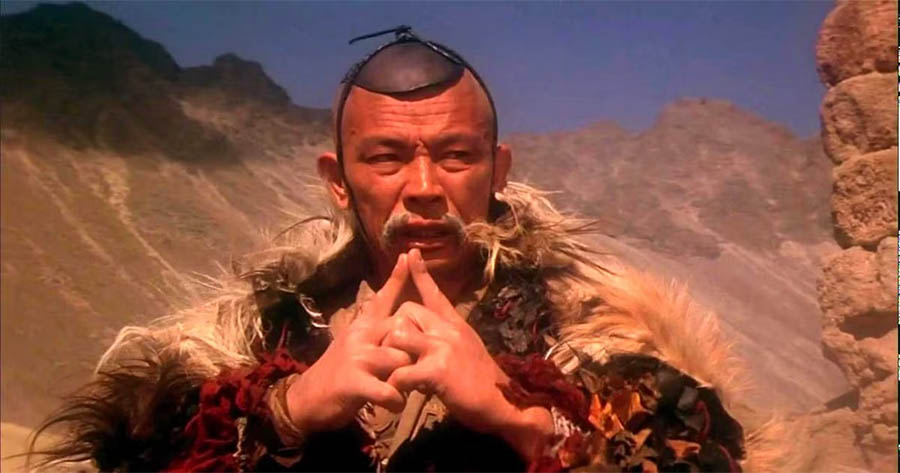
The Japanese-American actor Mako Iwamatsu, known professionally as “Mako,” was brought into the project by Milius for his experience; he had acted in many plays and films and had been nominated for both an Oscar and a Tony. In Conan, Mako played the Wizard of the Mounds and gave voice to the film’s opening speech. William Smith, though passed over for the lead role, was cast as Conan’s father. Doom’s two lieutenants, Thorgrim and Rexor, were played by Sven-Ole Thorsen, a Danish bodybuilder and karate master, and Ben Davidson, a former Oakland Raiders football player. Cassandra Gava played the witch. Milius hired over 1,500 extras in Spain. Professional actors from the European film industry were also hired: Valérie Quennessen was cast as Osric’s daughter, Jorge Sanz played the nine-year-old Conan, and Nadiuska portrayed his mother.
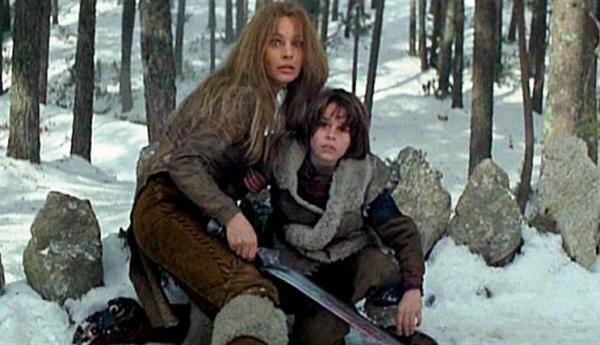
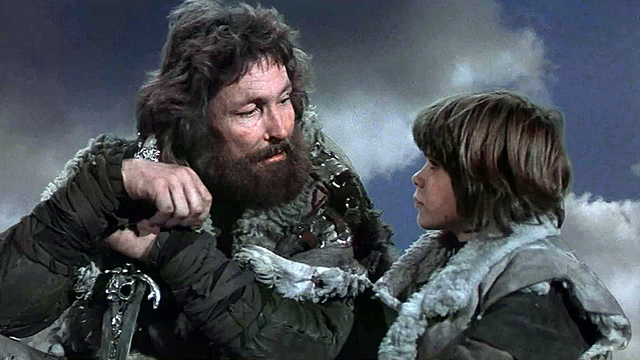
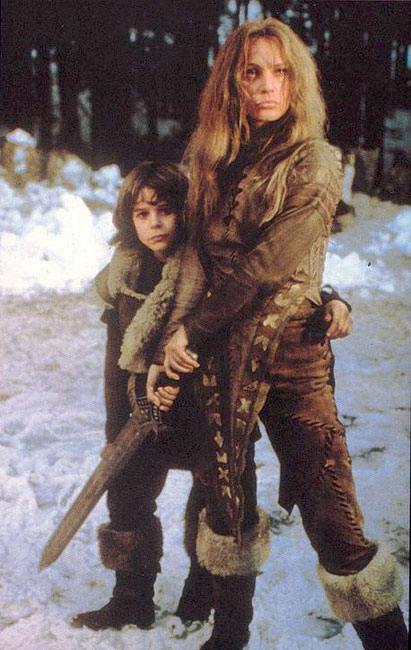
The filming took place mainly in Spain, where the crew faced adverse weather conditions and difficult terrain. Moreover, the film is known for its elaborate practical sets, including the construction of large outdoor settings such as Conan’s village, the city of Zamora, and the Tower of the Serpent. Milius’ dedication to authenticity also led to minimal use of special effects, opting for practical effects whenever possible. Conan’s village was indeed destroyed during Thulsa Doom’s attack, leaving no room for errors in filming.
In addition to the heavy training routine the actors endured, they also had no stunt doubles due to the difficulty of finding professionals with similar physiques. Schwarzenegger and Sandahl Bergman filmed all their own action or dangerous scenes. Both had accidents on set. Arnold, when pursued by dogs (in the film, they were wolves), lost his balance on the rocks after a dog jumped on him, falling several meters and injuring his back, requiring hospitalization. Sandahl Bergman nearly lost a finger during one of the sword fights she filmed.
Despite its success, the production of Conan the Barbarian was not without its problems. John Milius and producer Dino De Laurentiis frequently clashed over the tone and direction of the film. Milius wanted a more serious and philosophical approach, while De Laurentiis pushed for a more commercial and accessible style. Despite these tensions, their collaboration resulted in a film that balanced action and depth.As a curiosity, Franco Columbu, Arnold Schwarzenegger’s best friend, made a cameo in the film as a Pictish scout and helped the Austrian in his training.
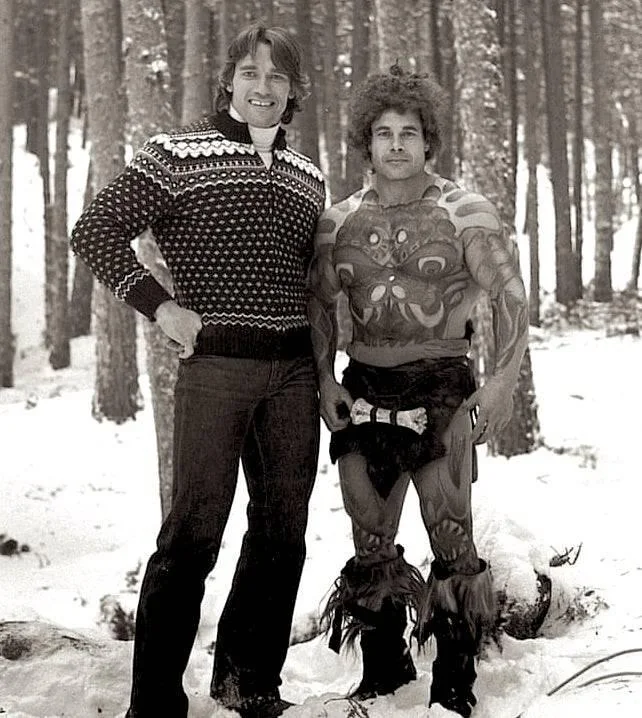
Conan the Destroyer (1984) followed the success of the original film but aimed for a more accessible audience by reducing the violence and adding more humor. However, the decision to soften the tone did not sit well with fans of the first film, and the sequel was less successful, both critically and commercially. Nevertheless, Conan the Destroyer is still remembered for its adventure, charismatic cast, and unique take on the fantasy genre.In addition to films, Conan has inspired a series of adaptations across various media, including comic books, animations, television series, and games. The character remains a key reference in the fantasy genre, embodying the archetype of the barbarian hero who battles supernatural forces and faces epic challenges.
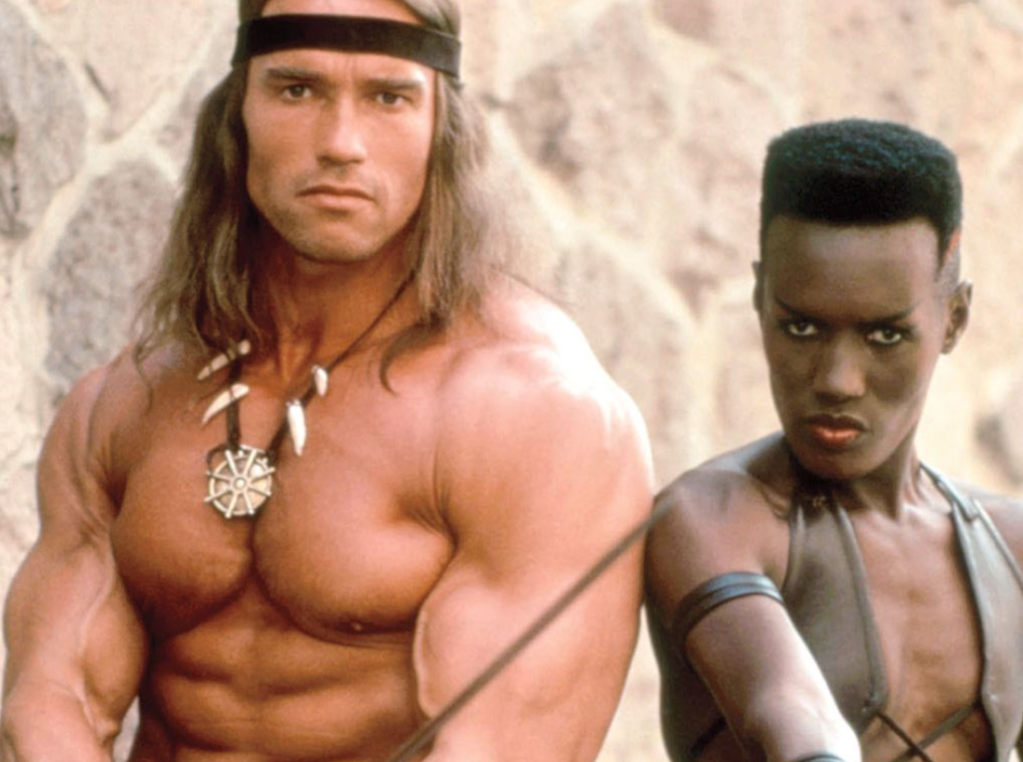
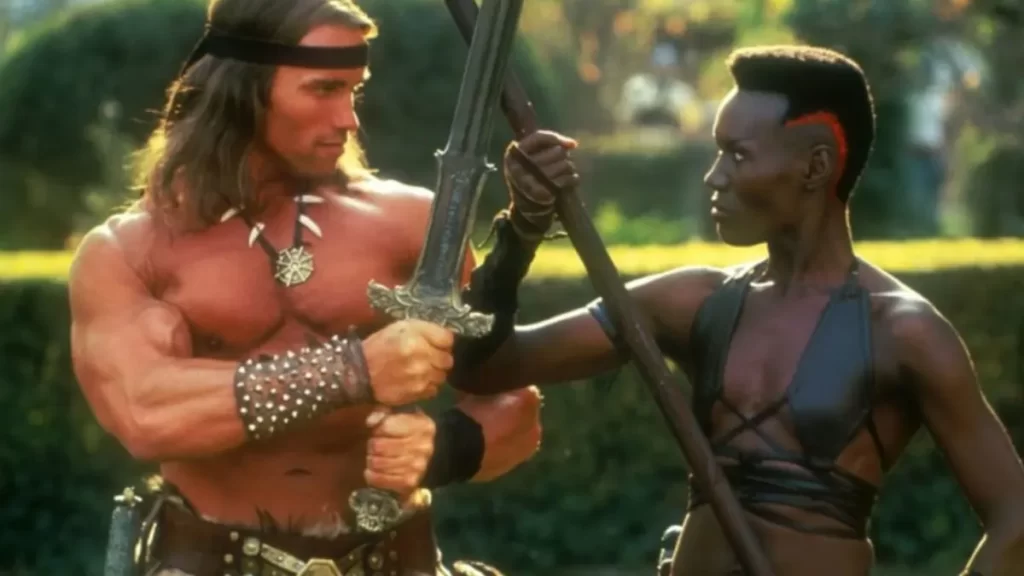
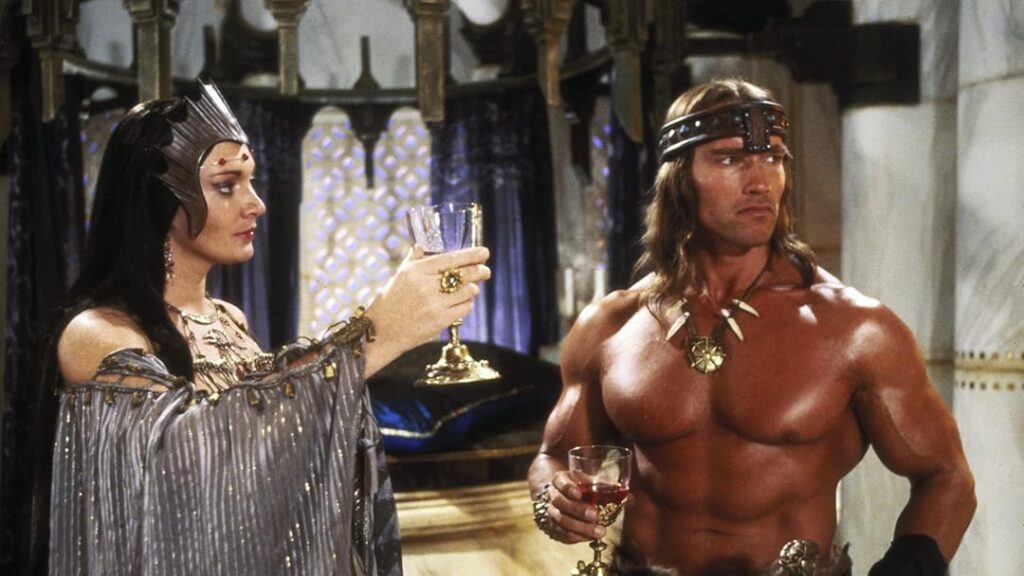
Biographies of the Lead Actors
Arnold Schwarzenegger (Conan)Arnold Schwarzenegger, born on July 30, 1947, in Thal, Austria, is an actor, bodybuilder, and politician. Before rising to stardom in the film industry, Schwarzenegger was a renowned bodybuilder, winning the Mr. Olympia title seven times. His portrayal of Conan the Barbarian was one of the first major roles in his film career, which would later include blockbuster successes such as the Terminator franchise and Predator. Schwarzenegger also served as the Governor of California from 2003 to 2011.
James Earl Jones (Thulsa Doom)
James Earl Jones, born on January 17, 1931, in Arkabutla, Mississippi, is a celebrated actor known for his deep, resonant voice. In addition to playing Thulsa Doom in Conan the Barbarian, Jones is famous for voicing Darth Vader in the Star Wars saga and for his role in Field of Dreams. His illustrious career in theater, film, and television has garnered him numerous accolades, including a Tony Award and an honorary Academy Award.Sandahl Bergman (Valeria)Sandahl Bergman, born on November 14, 1951, in Kansas City, Missouri, is an actress and dancer. Prior to portraying Valeria in Conan the Barbarian, Bergman was known for her work on Broadway, particularly in A Chorus Line. Her performance in Conan earned her a Golden Globe Award for New Star of the Year. Bergman also appeared in films such as All That Jazz and Red Sonja.
Mako Iwamatsu (Akiro, the Wizard)
Mako Iwamatsu, known simply as Mako, was born on December 10, 1933, in Kobe, Japan. He was an actor and voice artist, nominated for an Academy Award for his role in The Sand Pebbles. Besides playing the wizard Akiro in Conan the Barbarian and Conan the Destroyer, Mako also voiced characters in animated series, most notably Uncle Iroh in Avatar: The Last Airbender. He passed away on July 21, 2006.
Gerry Lopez (Subotai)
Gerry Lopez, born on November 7, 1948, in Honolulu, Hawaii, is a professional surfer and actor. Known as one of the greatest surfers of his generation, Lopez portrayed Subotai, the archer and companion of Conan. Though his film career is limited, his role in Conan the Barbarian is memorable, and he continues to be a legend in the world of surfing.
Max von Sydow (King Osric)
Max von Sydow, born on April 10, 1929, in Lund, Sweden, was a renowned actor whose career spanned more than seven decades. He played King Osric in Conan the Barbarian and is widely recognized for his roles in films such as The Seventh Seal, The Exorcist, and Star Wars: The Force Awakens. Von Sydow received several Oscar nominations and other awards throughout his illustrious career. He passed away on March 8, 2020.
Ben Davidson (Rexor) and Sven-Ole Thorsen (Thorgrim)
Ben Davidson, born on June 14, 1940, in Los Angeles, California, was a professional football player and actor. He portrayed Rexor, one of Thulsa Doom’s lieutenants. Sven-Ole Thorsen, born on September 24, 1944, in Copenhagen, Denmark, is a bodybuilder, actor, and stuntman. He played Thorgrim, another of Thulsa Doom’s lieutenants. Both actors brought an imposing physical presence to their roles. Davidson passed away on July 2, 2012.
In conclusion, the cinematic adaptation of Conan is a rich and complex saga, reflecting both the timeless qualities of the character and the dynamics and challenges of film production. Basil Poledouris’ soundtrack remains one of the film’s most iconic elements, leaving an indelible mark on the barbarian’s legacy on screen. The performances of the lead actors greatly contributed to bringing Conan’s world to life, with each actor leaving their own unique imprint on the film.
